Insightful Documentation Discovered About German Takeover Attempt of the TPV
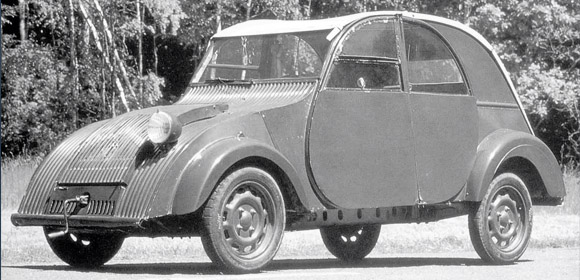
A 73-year old document discovered in the archives of The Conservatoire Citroën has shed some light on the intense interest the Germans had in getting their hands on the Citroën’s Type A TPV (Tout Petite Voiture – the prototype to the 2CV) that the company was working on in the late 1930’s. It reveals how close the now-famous deux chevaux came to being replaced by the Volkswagen Beetle.
Ronan Glon of RanWhenParked.net wrote in detail last month about the document and how persistent the Germans were, giving further insight into Citroen’s effort to prevent Citroen’s innovation from falling into German hands.
Citroën was planning to introduce their Type A at the 1939 Paris Auto Show, but the event was canceled when World War II broke out. Pierre Boulanger, managing Director of Citroën at that time, asked that the 250 pre-production cars already assembled be hidden as fast as possible so that the German forces wouldn’t see them. Several TPVs were buried at secret locations, one was disguised as a pickup, and the others were destroyed. For over half a century it was believed that the project was so well hidden that the all the prototypes were lost at the end of the war. (In fact it seems that none of the hidden TPVs was lost after the War, but in the 1950s an internal memo ordered them to be scrapped). Two prototypes were known at that time to have survived that order; a pick-up and one TPV 4 door. Then in 1994, 3 more 4 door TPV prototypes were discovered stashed in the attic of the Citroën testing facility near La Ferté-Vidame. (They had been placed there, hidden from the top management, by some workers who were sensitive to their historical value).
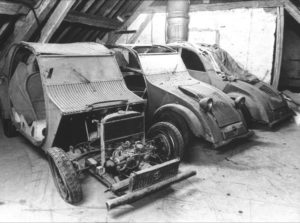 3 TPVs as found near La Ferté-Vidame
3 TPVs as found near La Ferté-Vidame
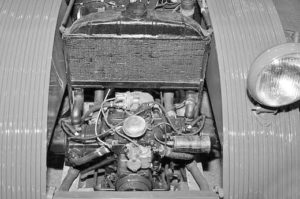 TPVs had a water-cooled 700cc, horizontally opposed, two cylinder engine capable of propelling the car to a top speed of almost 60 kph.
TPVs had a water-cooled 700cc, horizontally opposed, two cylinder engine capable of propelling the car to a top speed of almost 60 kph.
It is likely that the Germans captured one of the 1939 prototypes when they occupied the remains of the Levallois factory with its TPV production line in July of 1940. The car was sent to Wolfsburg where an unimpressed Dr. Ferdinand Porsche pronounced that it was “…more a soapbox jalopy than a people’s car…”
“The Germans asked us to hand over three cars,” explains the single-page document. Citroën officials were assured their design wouldn’t be copied because the cars would only be shown to Adolf Hitler and his aides, not to any of the nation’s automakers. In exchange, the German government would give Citroën its own version of what’s referred to in the document as “a people’s car,” and the company would be allowed to market it however it wanted to.
The terms of the proposed deal were never made public, so what the government wanted in exchange is anyone’s guess. However, the Germans were serious enough about letting Citroën build the Beetle in its factory for the local market that they were willing to send Dr. Porsche over to France to answer any and all technical questions about his creation.
Citroën remembers it immediately turned down the offer. There was no way it would abandon the TPV project, especially not to build Germany’s people’s car instead. Over the next year, German officials tried to convince Citroën to build the Beetle on at least six occasions, sometimes using threats as a means of persuasion, but executives never caved in.
As a last resort, the German government shipped one of its people’s cars to Citroën headquarters in Paris. Company officials present when the car arrived insisted it be immediately covered up with a tarp, and they ordered everyone in the vicinity to ignore it and carry on as normal. Discouraged, the Germans took the car and left.
Germany’s attempts to build the Beetle in France were summarized in a typewritten letter on December 26, 1944. Unfortunately, it’s not signed so we don’t know who wrote it, or who it was destined for. However, the author explains the German forces’ repeated visits represent one of the reasons why the Type 2CV A was completely (and secretly) redesigned during the war.
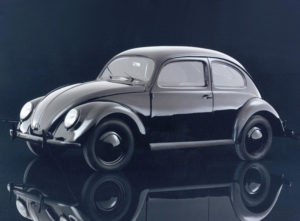

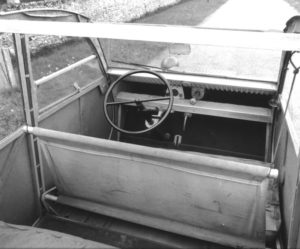
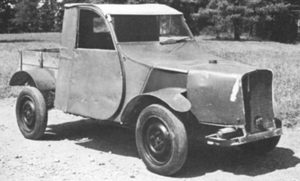


Great article, thanks for sharing useful content. Regards, David the author of the blog: https://deteced.com/